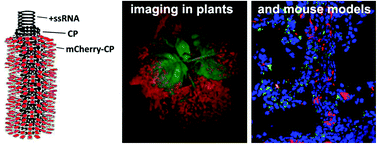Molecular farming of fluorescent virus-based nanoparticles for optical imaging in plants, human cells and mouse models†
Abstract
The application of plant virus-derived nanostructures in materials science, biomedical research and engineering has recently been promoted by the development of fluorescence-labeled viruses for optical imaging in tissue culture and preclinical animal models. Most studies reported thus far have focused on the application of viruses that have been chemically modified with organic dyes. In this investigation, we sought to develop and study genetically-engineered virus-based biomaterials that incorporate green or red fluorescent proteins. The genetic introduction of such imaging moieties is advantageous because post-harvest modifications are not required, thus minimizing the number of manufacturing steps and maximizing the yields of each fluorescent probe. Specifically, we engineered the filamentous plant virus Potato virus X (PVX) to display green fluorescent protein (GFP) or mCherry as N-terminal coat protein (CP) fusions, producing a 1 : 3 fusion protein to CP ratio. The infection of Nicotiana benthamiana plants with the recombinant GFP-PVX and mCherry-PVX particles was documented by fluorescence imaging, structural analysis and genetic characterization to determine the stability of the chimeras and optimize the molecular farming protocols. We also demonstrated the application of fluorescent mCherry-PVX filaments as probes for optical imaging in human cancer cells and a preclinical mouse model. Cell viability assays and histological analysis following the administration of mCherry-PVX indicated the biocompatibility and rapid tissue clearance of the particles. Such particles could therefore be functionalized with additional cancer-specific detection ligands to provide tools for molecular imaging, allowing the investigation of molecular signatures, disease progression/recurrence and the efficacy of novel therapies.

- This article is part of the themed collection: Emerging Investigators

 Please wait while we load your content...
Please wait while we load your content...